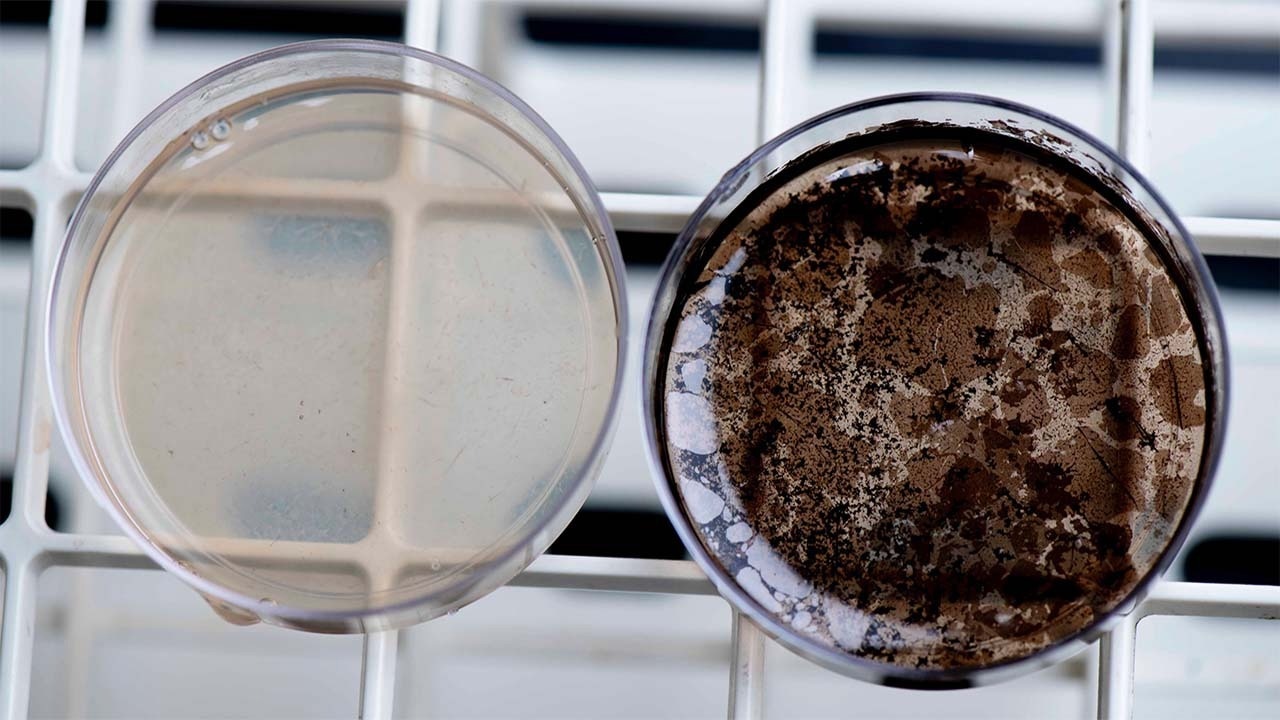Exploring the mysteries of the natural pigment melanin in the unique microgravity environment of the International Space Station (ISS) could lead to groundbreaking advances in biomaterial production on Earth and beyond.

(Left) Common Escherichia coli (a non-melanin producing strain) and (right) an E. coli strain bioengineered to produce melanin in liquid media. A melanin biofilm is observable in the engineered strain. Image Credit: Jonathan Steffen and the U.S. Naval Research Laboratory
An experiment from the U.S. Naval Research Laboratory will study microbes in space to try to uncover new melanin variants for applications ranging from radiation-resistant protective coatings for spacecraft and space suits to improved drug delivery and stability. The investigation, sponsored by the ISS National Laboratory® and launching on SpaceX’s 29th Commercial Resupply Services mission, aims to lay the foundation for the in-space production of melanin biomaterials.
Melanin is a natural pigment found in various species on Earth, from humans to fungi. It is renewable, biodegradable, and can replace toxic and unsustainable materials currently used in several applications. Melanin is known for its ability to protect against harmful environmental factors such as radiation and chemicals. Melanin has received renewed interest in investigating its use as a protective material for space applications following the discovery that fungi at the site of the famous Chernobyl nuclear power plant disaster produce copious amounts of melanin as a protective mechanism. However, the impact of microgravity and cosmic radiation on microbes’ production of melanin still has many open questions.
"Melanin is a fascinating pigment with enormous potential for a wide range of applications," said Zheng Wang, a U.S. Naval Research Laboratory biologist leading the project. "By studying melanized microbes in space, we hope to unlock gene expressions that are impossible to investigate on Earth and reveal new types of melanin and potentially even other novel biomaterials."
The project will shed light on the influence of space conditions on melanin production in microbial organisms. Microgravity may alter the microbes’ molecular processes by decreasing the settling of small particles or altering heat movement. This may result in the production of new melanin variants possessing previously undiscovered characteristics in terms of their physical and chemical behavior. Melanin is a complex and diverse pigment, and its properties can vary depending on factors such as its source, synthesis method, and environmental conditions.
Production in the space environment may even lead to “more perfect” melanin structures. This could facilitate research into melanin’s potential and help scientists discover new and improved uses for the pigment on Earth and in space.
By cultivating melanin-producing microbes in a bioreactor on the space station, the research team will investigate melanin's role in microbial adaptation to the space environment. Microbial strains that lack protective melanin will also be cultivated on station to compare with the melanin-producing strains. This will allow the team to search for novel protection mechanisms provided by melanin. Once the microbial samples are returned to Earth, the team will conduct DNA, RNA, and metabolite analyses to identify any changes in the genome, gene expression, and metabolism induced by spaceflight. The researchers will also compare the melanin produced in space versus melanin produced on Earth to look for differences in structure and properties.
This project is part of a broader research initiative by the U.S. Naval Research Laboratory to one day produce melanin biomaterials in low Earth orbit, on the Moon, and even on Mars. Wang said he hopes the insights gained from this study will pave the way for creating materials that can withstand the harsh space environment and revolutionize the development of biomaterials in space.
"We’re excited to discover whether microbes can produce melanin in large quantities in low Earth orbit. If it works, we can eventually build a facility for their mass production in space," he said. “We hope this work will not only inform the production of biomaterials but also contribute to the development of antibiotics or even growing food in space—that’s the dream.”
The mission is targeted for launch from Kennedy Space Center no earlier than November 9, 2023, at 8:28 p.m. EST. This mission will include more than 15 ISS National Lab-sponsored payloads.